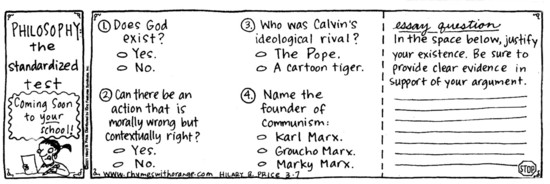| The
Professor's background (back to top)
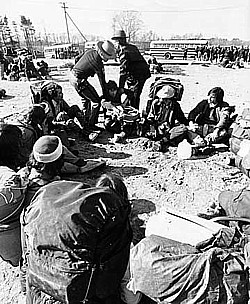
arrest at Seabrook
occupation, May 1977
|
After the general introduction about course policies, requirements and
content, I went on to tell about my own background in history, under the
motto: "who will be teaching you this quarter?".
- I started out as a physics major at a small liberal arts college in
Connecticut (Wesleyan). I was pretty naive, chose my major because I
was really good at physics and enjoyed it. I took a lot of survey courses,
in just about every field EXCEPT history. (I tried one course, but found
it deadly boring--it just didn't mean anything to me.)
- I was very interested in energy production, especially in alternative
energy sources. Knowing how utterly dangerous, stupid and energy inefficient
nuclear power is, at the end of my junior year I participated in the
May 1977 occupation of the Seabrook, New Hampshire nuclear power plant
construction site. I was arrested (along with about 2000 other people),
and happened to be one of the few who was put on trial. As a consequence,
I missed my final exams and was not allowed to make them up. I then
went on my planned senior year abroad in Germany, and (with a few twists
and turns) ended up staying there and ended up getting a Master's degree
in history of art, with a thesis about the monuments and memorials that
had been established to commemorate the civilian, military and Holocaust
victims of the Nazi era. That turned into a traveling exhibition with
a brochure "Stones
of Contention". I showed a map with icons of many of the monuments
we interpreted in that exhibition:
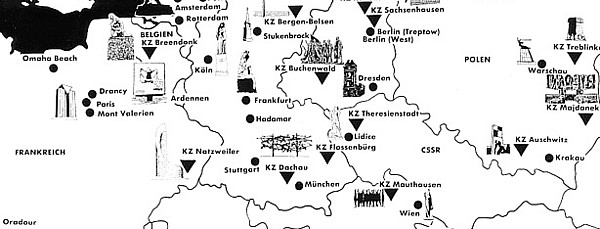
- Finally,
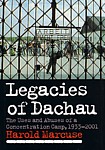 I
talked about the research project about the history of the former
Dachau concentration camp (that is, its history since 1945) that became
my Ph.D. dissertation in history and was ultimately published in 2001
as a book, Legacies of Dachau: The Uses and Abuses of a Concentration
Camp, 1933-2001. (See my Legacies
of Dachau
book page for more information.) I
talked about the research project about the history of the former
Dachau concentration camp (that is, its history since 1945) that became
my Ph.D. dissertation in history and was ultimately published in 2001
as a book, Legacies of Dachau: The Uses and Abuses of a Concentration
Camp, 1933-2001. (See my Legacies
of Dachau
book page for more information.)
- Long after visiting the site (and being basically overwhelmed
by the scope of it and all the information) I saw an artwork that
prompted me to remember a church I had seen there. I asked myself:
Why is there a church in Dachau? And the rest is, well, history.
 |
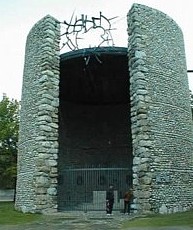 |
|
The artworks
that reminded me of the church in Dachau: reliefs with attributes
of St. Dorothy, St. Barbara (tower), and St. Catherine (wheel)
|
The Catholic
"Church of the Mortal Agony of Christ" in the
Dachau memorial site, 1960 |
- For more background on the history of Dachau after 1945, see my 2002
Hist 33D lecture 15 with lots of illustrations. (L14
covers Dachau 1933-45, but doesn't include images)
|


 Some
teachers think of it as cumulatively adding bits of knowledge to someone's
mind, like putting coins into a piggy bank. While that model may be
suitable to hierarchical disciplines like mathematics, I don't think
that it is a very interesting or useful way of teaching history. Instead,
I like to think of teaching as more like planting a seed. Plant one
good idea in the "soil" of a mind, add the "water"
of additional information and examples, and let the light of the university
environment shine on it, and you might get a big yield of meaningful
understanding.
Some
teachers think of it as cumulatively adding bits of knowledge to someone's
mind, like putting coins into a piggy bank. While that model may be
suitable to hierarchical disciplines like mathematics, I don't think
that it is a very interesting or useful way of teaching history. Instead,
I like to think of teaching as more like planting a seed. Plant one
good idea in the "soil" of a mind, add the "water"
of additional information and examples, and let the light of the university
environment shine on it, and you might get a big yield of meaningful
understanding.

 Using the course homepage logo, a world map scaled by population,
I tried to illustrate that there are various ways of determining
importance (like number of population, or geographic size, or wealth,
or military might).
Using the course homepage logo, a world map scaled by population,
I tried to illustrate that there are various ways of determining
importance (like number of population, or geographic size, or wealth,
or military might).